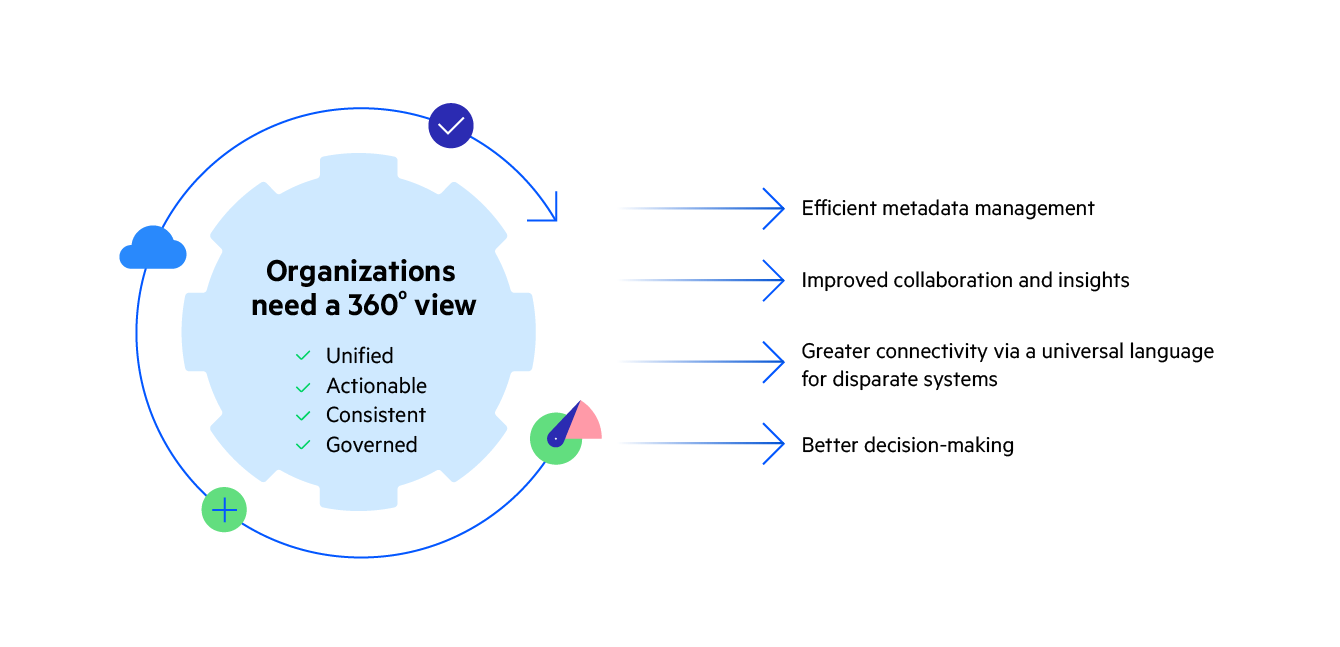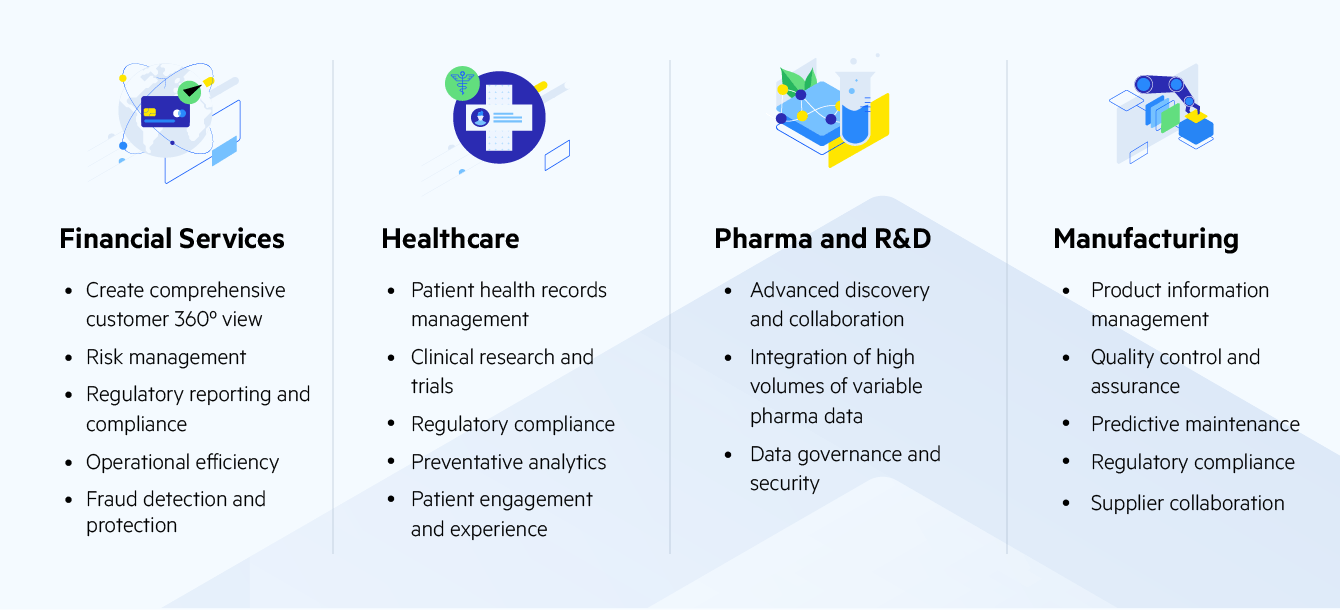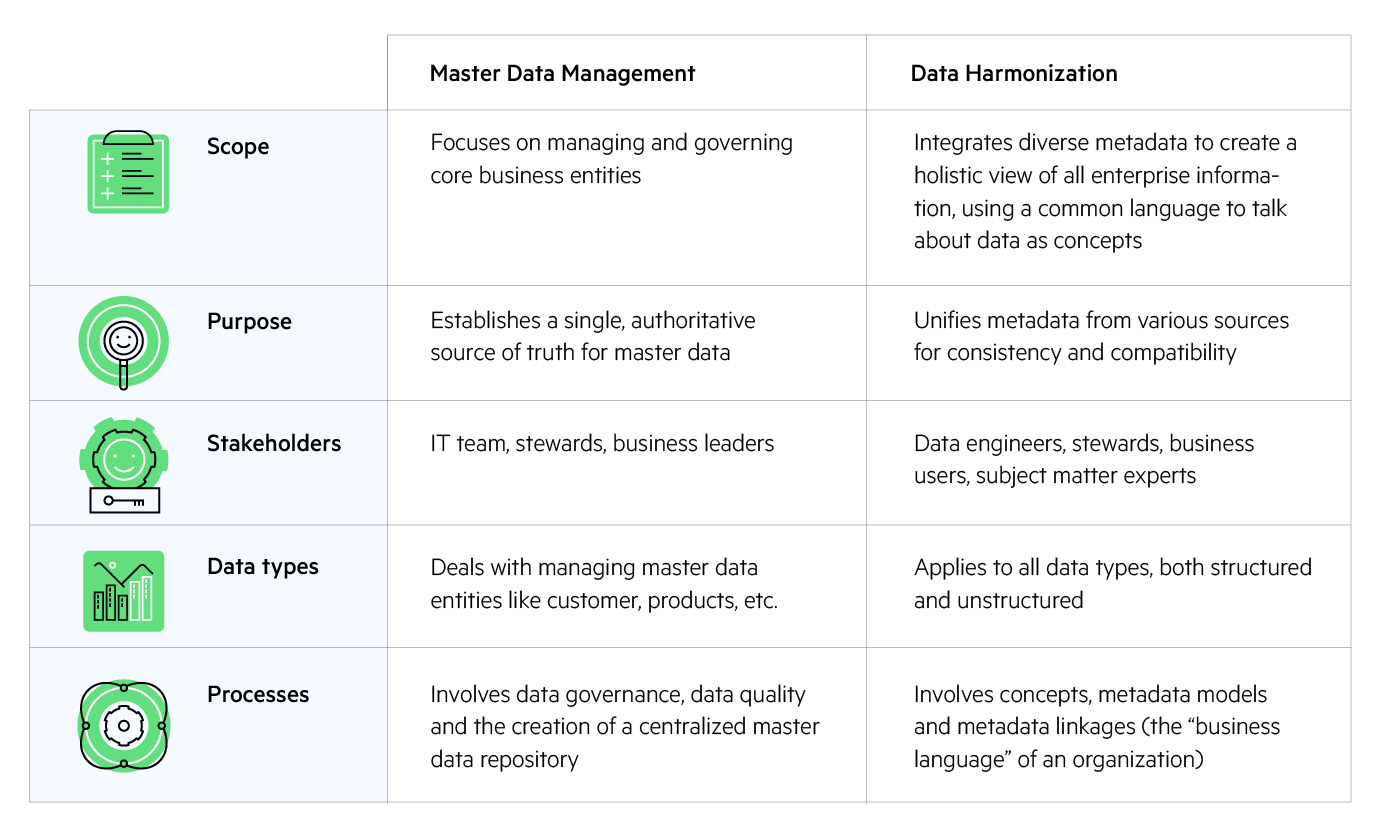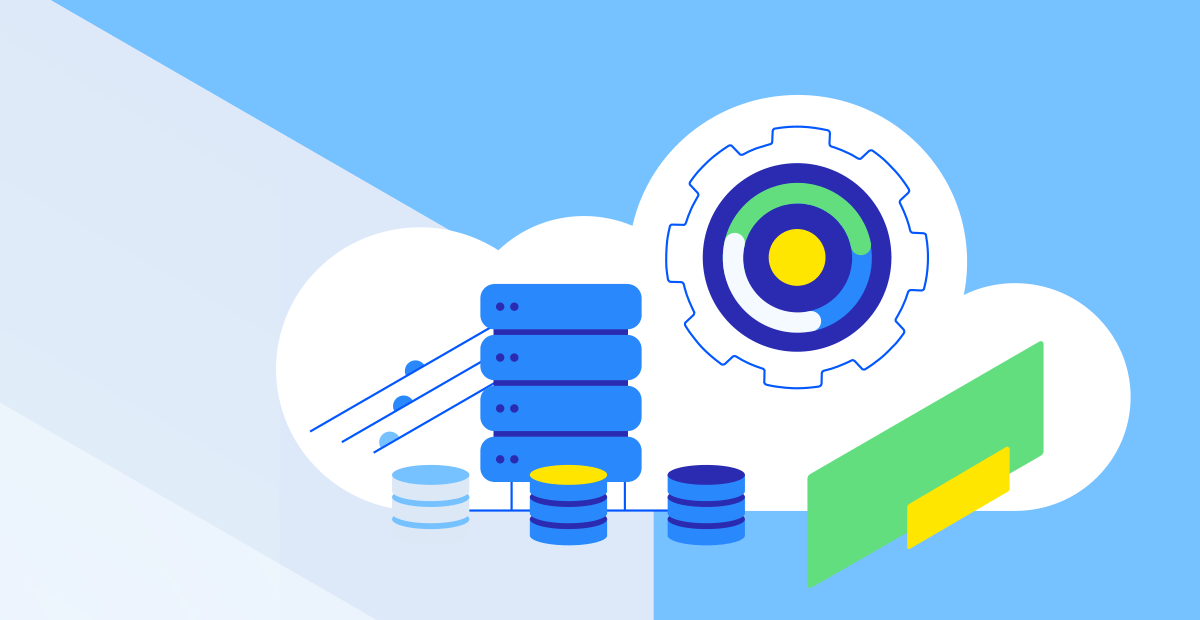Data can power businesses into the future, but only if organizations can make sense of it all. Data harmonization helps companies refine and unify diverse datasets, paving the way for clearer insights, machine learning, data quality and smarter, data-driven decision making.
In today’s dynamic work environment, businesses are facing an immense volume of both structured and unstructured data, streaming in from various sources. While structured data, residing in databases and spreadsheets, offers clear formats and organization, unstructured data from sources like emails, social media and documents presents a wealth of valuable but often untapped information. This information is often fragmented—dispersed across the enterprise in various formats and types. Amid this wealth of information lies a challenge and an opportunity for businesses: how can these disparate datasets be united into a coherent and meaningful whole?
Data harmonization is the process of defining a common language to your data from different data sources, formats and structures to create a holistic view of all enterprise information—regardless of its location or type. This common language can be used by businesses to make smarter decisions. It’s not merely about blending information; it’s about refining, cleansing and aligning data elements in a single unified schema.
Data harmonization is critical when dealing with multiple data sources, legacy systems or diverse datasets—all of which impact the entire organization. Data harmonization helps connect data across business processes, identify sensitive information and uncover your most valuable assets.
According to recent research by the Business Insider (2023), 69% of CFOs consider having a single source of truth for enterprise data critical for running an enterprise.

With data harmonization, companies can channel data from various sources into a more holistic, standardized and comprehensive view across the organization. With Progress Semaphore, companies can create a more unified view of their data, while keeping their data in their systems of records and applying metadata tags to improve their understanding of that data.
How Does Data Harmonization Work?
Data harmonization is a critical part of streamlining data information management. The process of data harmonization will vary from organization to organization, depending on the variety and volumes of data, the specific context and the business priorities.

- 1. Define Your Metadata
The first step in data harmonization is to define your metadata. Some organizations get tripped up by assuming they must have one metadata model. This is not the case. In fact, you will probably have several. For example, you may want to leverage industry-defined metadata models and incorporate those into your own business vocabulary. It’s okay to have multiple models within your company, but its paramount that you understand the linkages between them.
- 2. Harmonize
Now that you have created a “common language” by properly defining your metadata, you can classify, auto-tag, enrich and extract your data regardless of source or type. Join data from different sources—varying file formats and naming conventions—and transform it into a cohesive data set.
- 3. Integration, Deployment and Visualization
Whether you’re using Power BI, Tableau or a simple pivot table in a spreadsheet, you’ll need to connect your data to your business intelligence tools. There’s no one-size-fits-all approach to this step, but you should select your data harmonization tools with a robust API so you can make the necessary connections to your toolsets. This will help equip you with a true 360-degree view of your data.
Why Do We Need Data Harmonization?
The shift towards a data-centric business economy has increased the pace of data collection and the need to orchestrate this data into a harmonious and coherent whole. Businesses are facing an exponential surge in the rate of terabytes of new data generated daily, which according to Statista (2020) will be over 181 ZB by 2025. The data required for making important business decisions may come in different forms and formats. It could originate from customer research, market research or various departments within the organization.
Unstructured data stands to be one of the most valuable resources in an organization, and its rate of growth is staggering. However, companies rely mainly on their structured data and use it to make business decisions. The reality is that typically only 20% of an organization's data is structured, which can lead to bad business decisions because organizations often ignore the other 80% of their data, which is unstructured. This can result in chaos, inefficiency and missed opportunities. When data is harmonized, there’s a greater chance of finding missing patterns and pieces of new data, which can ultimately impact results. Additionally, when data isn’t spread out or presented in different forms, it makes it less likely that opportunities will get overlooked by management.
This rapid growth can be even more painful when organizations lack the advanced technology and management systems to extract value from their data. Using technologies like knowledge graphs, data harmonization software and a semantic metadata hub to harmonize information can have a significant impact on every aspect of the enterprise, from linking data across business processes and identifying sensitive information to discovering the organization's most valuable assets. With these types of technologies, organizations can:
- Bring together different data types from various sources to present a single view of the organization's information.
- Deliver real-time access to relevant information to both internal and external stakeholders for the purpose of analysis, reporting and management.
- Better comply with regulatory mandates to reduce the risk of organizational and reputational damage and avoid penalties.
- Act as a fundamental building block for developing smarter applications, data warehouses and machine learning initiatives.
Data harmonization makes it possible for organizations to transform fragmented and dispersed data into valuable information for creating new insights, analyses and visualizations.
Benefits of Data Harmonization
Data harmonization offers a wide range of benefits to business users. From streamlined operations to enhanced business intelligence and decision-making capabilities, data harmonization emerges as a cornerstone, empowering enterprises to extract value from their data. The following are some of the main business benefits:
- Unification of diverse data sources – Organizations accumulate data from various sources with diverse formats, structures and standards. With data harmonization, diverse datasets can be seamlessly connected to create a more complete and nuanced view of business operations, customer sentiment and market trends. This enables businesses to see the bigger picture and make more informed decisions.
- Eliminate data and metadata silos – Data harmonization enables cleaner access to your data, facilitating uniformity in definitions, values and meaning. This consistency helps minimize complexity, improves the overall quality of business data and enhances the reliability and usability of information for analysis and decision-making.
- Facilitating data analysis and machine learning – Harmonized data simplifies analysis and the generation of more accurate insights and forecasts by providing a unified view. Insights derived from structured data can be enriched with unstructured data, offering deeper context and accuracy as well as improving machine learning algorithms.
- Enable better decision-making – Harmonized data fosters more informed decisions and streamlines data processing, leading to greater accuracy and reliability in business decisions. With a more centralized view of data, companies can become more agile and respond better to market changes.
- Enhance cross-department collaboration – The collaboration between teams is improved by establishing a unified language and framework for data interpretation. It enhances communication, reduces misunderstandings and fosters a more unified approach to data-driven initiatives by providing a “common language.” Leverage data harmonization to knock down the data silos between your teams.
Enhanced compliance and governance – Data harmonization supports regulatory compliance and data governance by providing the underlying framework to describe and identify every type of data throughout your business, whether structured or unstructured.
Data Harmonization Best Practices
The following best practices offer a guide for navigating the challenges associated with harmonizing data, promoting data quality and facilitating seamless integration for organizations seeking a unified and reliable data foundation.
Data harmonization generally involves the combination of automated processes and manual methods, which requires expertise from data stewards in automating the overall process and implementing a data harmonization strategy.
Create a metadata model—or models—that can adapt to future needs. This enables organizations to react quickly to changing business requirements.
Before starting data harmonization efforts, set clear goals, identify potential challenges and gain a comprehensive understanding of your company’s data. Have a clear vision of what data harmonization is all about and the results your company wants to achieve. Don’t try to boil the ocean. Prioritize your use cases and pick one to start with. Once you achieve success in one data harmonization project, others will fall into place with less effort.
Data Harmonization High-Quality Examples
Data harmonization use cases varies across industries, depending on the variety and volumes of data, the specific context and the business priorities. From healthcare to finance, manufacturing to media, companies are navigating complex data environments by harmonizing their data to unlock the full potential of their diverse data sets.
The more data you have and the more “specialized” your language is that you use to talk about your data internally, the higher need you will have for data harmonization. Do you use acronyms to describe acronyms to describe acronyms as a common course of your business? If so, chances are you are ripe for simplifying your business with a data harmonization strategy.

A good data harmonization example is the multinational biotechnology company, Amgen, which works with thousands of suppliers that supply hundreds of thousands of items. They wanted to enhance logistics intelligence to improve supply chain efficiency and understand which items across which suppliers were the same and do it efficiently. The company used Progress MarkLogic multi-model data platform and Semaphore’s semantic AI capabilities to harmonize data from disparate sources and create a unified dataset, resulting in improved efficiencies.
What’s the Difference Between Data Harmonization and Master Data Management?
While data harmonization focuses on aligning and integrating diverse datasets from various sources to create a consistent data view, master data management is a more strategic initiative, involving the management and governance of core business entities to provide a single, reliable source of truth. Master data management focuses on the creation and maintenance of master data, implementing data governance policies and facilitating consistency and quality in master data.

Data harmonization and master data management are complementary strategies. While data harmonization focuses mainly on the consistent application of data and metadata, master data management focuses primarily on the instance (or record) data itself.
Unlock the Full Potential of Your Data for Better Business Decisions
Bridging the gap between structured and unstructured data is no longer an option but a necessity in today’s data-driven world. Moving forward, making critical data-driven business decisions with a complete set of enterprise information will be essential for business productivity and growth. By harnessing the power of all their data, organizations can gain a competitive edge, drive innovation and uncover valuable insights that fuel their growth.
Watch our webinar, Data Harmonization for Better Business Decisions, and discover first-hand how harmonizing your data can modernize your analytical capabilities, foster informed decisions and unlock hidden insights within your organization.

Stephen Reed
Stephen Reed is a Senior Account Executive with Progress. He has over 20 years of technology experience, ranging from artificial intelligence and computer networking to software development and design. Stephen holds a Bachelor of Science in Computer Engineering from Lehigh University and a Master of Science in Information Networking from Carnegie Mellon University.

